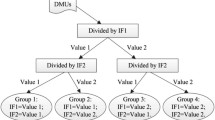Abstract
In organizations with a centralized decision making environment, production usually involves the participation of more than one individual unit, each contributing in part to the total production. The planning problem involves determining the number of products to be produced by all individual units in the next season when demand changes can be forecasted. This paper introduces a data envelopment analysis approach to making future production plans in a centralized decision making environment when demand changes can be forecasted in the next production season. The approach proposed in this paper takes the size of operational units into account so that the planned production for each unit becomes proportionate to the ability of the units. A real world data set is used to illustrate the applicability of the approach.
Similar content being viewed by others
References
Beasely JE (2003) Allocating fixed costs and resources via DEA. Eur J Oper Res 147:198–216
Charnes A, Cooper WW, Rhodes E (1978) Measuring the efficiency of decision making units. Eur J Oper Res 2:429–444
Chazal M, Jouini E, Tahraoui R (2008) Production planning and inventories optimization: a backward approach in the convex storage cost case. J Math Econ 44:997–1023
Cooper WW, Seiford LM, Zhu J (2004) Handbook of data envelopment analysis. Kluwer Academic Publishers, Norwell
Du J, Liang L, Chen Y, Bi G (2010) DEA-based production planning. Omega 38:105–112
Golany B (1988) An interactive MOLP procedure for the extension of DEA to effectiveness analysis. J Oper Res Soc 39(8):725–734
Kim B, Kim S (2001) Extended model for a hybrid production planning approach. Int J Prod Econ 73:165–173
Korhonen P, Syrjanen M (2004) Resource allocation based on efficiency analysis. Manage Sci 50:1134–1144
Matin RK, Kuosmanen T (2009) Theory of integer-valued data envelopment analysis under alternative returns to scale axioms. Omega 37(5):988–995
Pastor R, Altimiras J, Mateo M (2009) Planning production using mathematical programming: the case of a woodturning company. Comput Oper Res 36(7):2173–2178
Sharma S (2007a) A fresh approach to performance evaluation in a multi-item production scenario. Eur J Oper Res 178(2):627–630
Sharma S (2007b) A procedure for benchmarking in multi-product manufacturing. Proceeding IMechE, Part B, J Eng Manufact 221(1):135–140
Sharma S (2008a) On the flexibility of demand and production rate. Eur J Oper Res 190(2):557–561
Sharma S (2008b) Theory of exchange. Eur J Oper Res 186(1):128–136
Sharma S (2009a) A method to exchange the demand products for cost improvement. Int J Adv Manuf Technol 45:382–388
Sharma S (2009b) Single/multiple parameter swapping in the context of Sanjay Sharma’s theory of exchange. Int J Adv Manuf Technol 40:629–635
Author information
Authors and Affiliations
Corresponding author
Rights and permissions
About this article
Cite this article
Amirteimoori, A., Kordrostami, S. Production planning: a DEA-based approach. Int J Adv Manuf Technol 56, 369–376 (2011). https://doi.org/10.1007/s00170-011-3178-9
Received:
Accepted:
Published:
Issue Date:
DOI: https://doi.org/10.1007/s00170-011-3178-9




